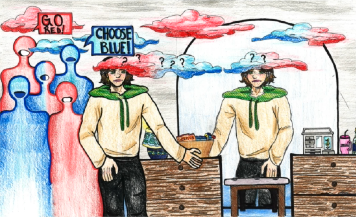Why Now is not the Time to Reopen the United States from COVID-19 Regulations
Over the past several months, a large portion of Americans have gotten the COVID-19 vaccine, and deaths or infections from the virus have gone down a good amount. Many citizens and unfortunately many government officials have taken this information as a reason to become extremely lenient on mask mandates and general COVID safety, but this is extremely irresponsible and not a path the U.S. should currently take. COVID-19 and its variants are still extremely dangerous and apparent in our country, and they must be dealt with to the maximum degree until it no longer poses a threat to the large majority of its citizens.
According to USAFacts, as of Sept. 25, 65% of the United States’ population has at least one dose of the COVID-19 vaccine, and 56% of the population is fully vaccinated. Because of this majority being completely or partially vaccinated, many people make the argument that because the vaccine is so readily available to most citizens, if citizens refuse to get vaccinated and test positive, it is their own fault. These people tend to believe the country should begin to reopen for the majorly vaccinated population, however there are many flaws with this argument that need to be acknowledged.
Again, according to statistics provided by USAFacts, currently an average of 121,543 U.S. citizens are testing positive for COVID-19 or its variants per day. Alongside this, an average of 2,400 citizens are dying of the disease as well. While the majority of the country’s population is in fact vaccinated, it is still by a relatively small margin, and if the country were to completely reopen, the amount of citizens that would be put at even greater risk is extremely high. It is not just a few thousand people.
Also, the argument implies that if an unvaccinated person were to catch COVID-19, it only affects them, when this could not be further from the truth. Those who could easily be vaccinated but refuse to are causing the chance of breakthrough cases, which are cases of COVID-19 that vaccinated people test positive for despite having received the vaccine, to increase significantly. In order to truly achieve herd immunity, which many view as the solution to our COVID crisis, there needs to initially be a very large immune population.
Unvaccinated people are also taking up hospital and intensive care unit (ICU) space and using vital resources that could be used for other purposes. It is widely known that most United States citizens have easy access to the COVID-19 vaccine, but still there are too many who choose not to receive it. This population of unvaccinated citizens take up ICU and hospital space when they could just get vaccinated and allow other citizens to receive care for other reasons.
Also, an obvious reason why reopening the country is a terrible idea that I believe isn’t getting enough recognition is that children under 12 are still not cleared to receive the vaccine, and easing restrictions only makes them significantly more susceptible and vulnerable.
So, while it is a bad idea to reopen the country due to too many unvaccinated citizens being put at risk, it is still urgent that those who are not vaccinated get the vaccine as soon as possible. The United States could almost be out of the heat of COVID-19, so while we shouldn’t reopen the country yet, we are nearing a time when we can. However, winter is approaching once again, and the winter of late 2020-early 2021, when the U.S. was having daily death counts of around 3,000 cases per day, showed us that COVID-19 is even worse during the colder times, and we need to get vaccinated before that time is upon us.
And it should be noted that at this point, there should be no hesitation for getting vaccinated. The COVID-19 vaccine, while being made quicker than others, has had just as much testing than any other vaccine in recent years. According to COVID Collaborative, COVID-19 vaccine testing follows a three-phase process. They describe the phases as follows:
- “Phase 1: The vaccine is tested in a small number of generally healthy adults, usually between 20 and 80 people…
- [In stage 2], if there are no safety concerns from Phase I studies, the vaccine is given in various dosages to hundreds of adults who come from different backgrounds and may have varied health issues…” Many people have been hesitant to get the vaccine due to worries of how it may relate to their preexisting conditions, but the doctors and scientists developing the vaccine are aware of this and have ensured its safety, or warned when it is not safe.
- They describe stage three as the stage at which “experts broaden the study to include thousands of adults from a variety of ages and backgrounds. They see how many people who got the vaccine were protected from the disease, compared to those who received a placebo.” In addition to this information, the Pfizer vaccine has been approved by the Food and Drug Association (FDA).
It is also really important that vaccinated people continue following COVID-19 restrictions and guidelines to set an example for those who are unvaccinated and do not believe in the science behind it. This way they do not harm themselves or others around them.
The COVID-19 Delta variant has also been a large problem throughout the world, including the U.S. It would just be sabotage to reopen the country while health organizations are still coming up with ways to deal with the variants. On top of finding solutions to deal with Delta, the question of whether or not boosters are needed has been circling around. A third COVID vaccine booster has been approved, and essential worker citizens can now receive them. Although they are currently not needed for everyone, they may be later, so the uncertainty should be figured out before the restrictions are drastically changed.
The United States has made immense progress regarding the COVID-19 pandemic in the past several months. Over half the country is fully vaccinated, and a portion of the population has their first dose as well. However, cases and deaths are still relatively high and are currently increasing due to restriction leniency. A large portion of the country’s population still needs to be vaccinated or cannot be yet. Variants are appearing and causing damage, and immunity for those vaccinated early may be starting to diminish, raising the question of if boosters are needed. We may be almost out of the pandemic, but we need to uphold strict guidelines and regulations for just a while longer. If we can do that, we will be out of this pandemic sooner than we think.

Name: Kevin Sigrist
Position: Advisor’s Assistant
Graduation year: 2024
A few sentences about me: Hi, I’m Kevin....






